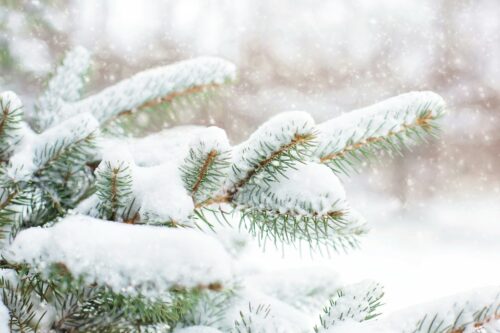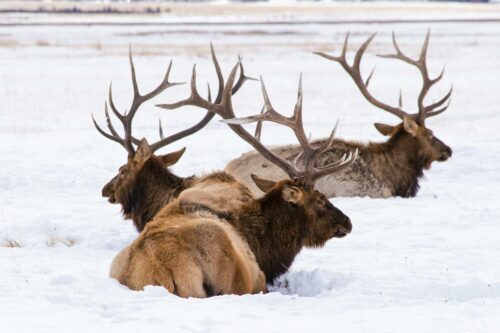It’s a Winter Wonderland!
Have you ever stopped to think about how remarkable the environment is in winter? We often focus so much of our energy on other seasons when nature seems to be teeming with life, like when buds open up on trees in the spring, that we forget how incredibly adaptable living things are to the climate and their changing environment.
Winter ecology studies the inter-relationships between animals, insects, and plants with their habitat in the winter. In many parts of the country temperatures reach freezing (or well below) and you have lots of snow, whereas other areas receive ample rain with milder temperatures.
How do we adapt to our environment? As humans we might put on a warm jacket, gloves, and a hat before we go outside to brave the cold. Maybe you huddle around the fireplace and wear a few extra blankets. In Germany people say “there’s no bad weather, only bad clothing”—they know that winter environments still offer abundant outdoor learning opportunities! Looking for outdoor teaching tips during colder months? Molly Gillespie, Alaska’s PLT Coordinator, recently shared some ideas for teaching outdoors in the winter.
But for trees and other living things, they have a plethora of adaptations to survive winter conditions. Let’s explore some of these!
Tree Adaptations
One of the most fascinating things about trees is how they protect themselves from the elements. In the “Signs of Fall / Señales de Otoño” activity from PLT’s Explore Your Environment: K-8 Activity Guide / Explora tu Ambiente: Guía de Actividades K-8, students learn about the different pigments found in leaves and why leaves change color and drop in the fall.
 Trees have winter defense mechanisms in place. Evergreen trees, like pine trees, have various characteristics that allow them to survive cold, wind, and snow.
Trees have winter defense mechanisms in place. Evergreen trees, like pine trees, have various characteristics that allow them to survive cold, wind, and snow.
- Narrow Leaves – With narrower leaves, it’s a smaller surface area so that means they are less vulnerable to heavy loads of snow that might break a tree branch.
- Waxy Layer – Evergreen leaves are coated with a thick wax. Think of the wax like a warm blanket – it keeps the leaves from drying out during long winters.
- Scents and Sensibility – Well, we’re actually talking about the chemicals found in evergreen trees. Have you ever taken a deep breath in the forest and there’s a very specific scent, say pine, you smell? Those chemicals not only produce that characteristic scent, but they also act as an antifreeze of sorts. They prevent ice from forming inside of the leaves!
As I told my son’s TK class, evergreens stay “forever green” (sort of!), and deciduous trees “decide” to drop their leaves. It’s my silly little mnemonic device to help kids remember the differences.
Dropping leaves is another mechanism trees have in place to prepare for winter. Cold temperatures cause the cells at the base of each leaf stem to die which creates a barrier to keep water and nutrients from going into the leaf and instead remain in the tree’s trunk and branches. When the cells die, the leaves drop off trees and remain dormant throughout the winter.
Activities to Explore Trees in the Winter
The winter environment offers an abundance of learning opportunities for preschoolers and we’ve assembled our favorite 10 winter activities for preschoolers to enjoy outdoors.
Looking for other ideas? Check out these other fun evergreen tree activities to do in the winter.
Nature-Inspired Art
If you have evergreen trees nearby, such as pine, spruce, cedar, fir or hemlock trees, get creative by turning the leaves into paintbrushes and have fun turning nature into art! Here’s a helpful how-to that you can accompany with the “Evergreens in Winter” activity from Trees & Me: Activities for Exploring Nature with Young Children.
Tree Identification
Take your learners on a nature walk and try to identify different types of evergreen trees based on their leaves. You can also do the “Tree ID / Identificación del Árbol” activity from PLT’s Explore Your Environment: K-8 Activity Guide / Explora tu Ambiente: Guía de Actividades K-8 to learn how to identify difference tree species based on their features!
Nature Journaling
Invite learners to bring a notebook, pencil, and some crayons with them outdoors and encourage them to write down or draw what they see, hear, touch, and smell. Do they hear the sound of snow crunching underneath their boots? The whistling of wind through the trees? Do they see footprints of a rabbit or dear? Do they smell pine trees? Make a bark or leaf rubbing in the journal. Write poetry about how they feel in nature. Press leaves into the journal. The possibilities are endless! Nature journaling is a perfect activity to accompany the “Adopt-a-Tree / Adopta un Árbol” activity from Explore Your Environment: K-8 Activity Guide / Explora tu Ambiente: Guía de Actividades K-8. Encourage students to pick one tree in their schoolyard or near their home and notice the changes in every season. For little learners, make an Our Favorite Trees scrapbook in the “My Tree and Me” activity from Trees & Me: Activities for Exploring Nature with Young Children.
Animal Adaptations
 Just like trees have their own winter protections, so too do animals and insects – migration, hibernation, and resistance. Let’s learn more about each adaptation:
Just like trees have their own winter protections, so too do animals and insects – migration, hibernation, and resistance. Let’s learn more about each adaptation:
- Preparing for Winter – As the temperature outside begins to drop, noticeable changes take place all around us. All living things, including humans, must adapt to their environment in order to survive. Let’s take a closer look at how plants and animals prepare for winter.
- Migration – Why do some birds fly south for the winter? Why do monarch butterflies migrate to Mexico starting in October? Why do elk move from high in the mountains in the summer to the base of the mountains in the winter? Many animals move to warmer climates or lower elevations to have access to more food and shelter and milder weather. Even earthworms travel deeper and deeper into the soil for warmth!
- Hibernation –When I think of hibernation, I picture a grizzly bear in Alaska packing on the pounds by eating lots of salmon and berries and sauntering into a dark cave to go to sleep for the winter. But there’s so much more to hibernation than that. According to the National Park Service, hibernation is “a physical state where an animal’s body function slows down in order to conserve energy through a season of no food and water, and cold temperatures.” This means their heart rate and breathing slow down so they don’t use too much energy. All that fatty salmon the grizzlies eat keeps them alive. But bears aren’t the only animals that hibernate. Marmots, raccoons, and even some squirrels hibernate.
- Resistance – There are a variety of other ways different species survive the dropping temperatures. Many animals who live in cold climates are much larger, such as polar bears, which means they have a higher body-mass-to-surface ratio, allowing them to tolerate the cold. Another way animals regulate their temperature is by fluffing feathers out, huddling together in large groups, or staying warm inside trees/logs/caves. Some animals have thicker fur, shorter ears and tails, increase food intake to store more fat, or even change color. These adaptations help keep them warm, survive with less food, and avoid predators or hunt for prey.
Activities to Explore Animal Adaptations
How Animals Stay Warm
In this science experiment, students learn how blubber keeps animals warm in freezing temperatures.
Biodiversity Matters
In the “Charting Biodiversity / Graficando la Diversidad” activity from PLT’s Explore Your Environment: K-8 Activity Guide / Explora tu Ambiente: Guía de Actividades K-8, students play a Spice of Life game, teaming up to match different animals and plants based on their characteristics and how they adapt to where they live.
Now You See Me, Now You Don’t!
Learn about how camouflage keeps certain birds (and insects) safe from predators in PLT’s activity collection, Together for Birds.
Arctic Animals STEM Activities
Get crafty, curl up with a good book, and learn about the web of life with some fun STEM activities. From engineering a den for arctic animals to understanding how and why sea ice is melting, children can learn more about life in the Arctic. Pair these with the “Web of Life / Telaraña de la Vida” activity from Explore Your Environment: K-8 Activity Guide / Explora tu Ambiente: Guía de Actividades K-8.
Prepare to Be Amazed by Winter!
Just because winter tends to be a time when life is in “rest mode” doesn’t mean learning needs to slow down. Winter ecology is fascinating to study! If you can bundle up and head outdoors, get hands-on with nature outside. Otherwise, bring nature indoors and continue learning and exploring!


